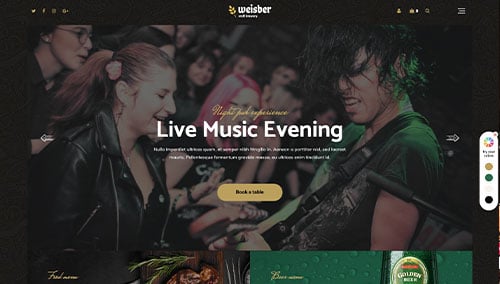Hello, beer enthusiasts! Want to discover the best breweries around the world and explore the world of craft beer? Our guide to the top 50 brewery websites is here to help.
Our team of digital marketing professionals has meticulously evaluated the best brewery sites, taking into account factors such as design, functionality, uniqueness, and user experience. From visually stunning designs to in-depth knowledge about craft beer, these sites embody excellence in the world of breweries.
Not only will you find inspiration for your own brewery website, but also gain valuable tips on how to create an online presence that showcases your passion and expertise in the world of craft beer.
Explore the world of craft beer and create an online presence that reflects the unique flavors and aroma of your brewery! You’ll find website examples of craft breweries, microbreweries, brewpubs, regional breweries, and online beer retailers in this list! For examples within other industries, head back to our innovative website designs article!
Top Brewery Website Designs
- 1. Stone Arch Brewpub
- 2. Threes Brewing
- 3. Against The Grain Brewery
- 4. New Glarus Brewing Company
- 5. Coors Light
- 6. Lion’s Tail Brewing Co.
- 7. The Dillon Dam Brewery
- 8. Four Peaks Brewing Co.
- 9. Third Space Brewing
- 10. Southern Star Brewing Co.
- 11. Archetype Brewing
- 12. DSSOLVR
- 13. New Belgium Brewing
- 14. Lexington Brewing & Distilling Co.
- 15. Camden Town Brewery
- 16. Gnarly Cedar Brewing
- 17. Flying Monkeys Craft Brewery
- 18. Blind Enthusiasm Brewing
- 19. Fate Brewing Company
- 20. Founders Brewing Co.
- 21. Reuben’s Brews
- 22. Sierra Nevada Brewing Co.
- 23. Bell’s Brewery
- 24. Stone Brewing
- 25. Driftwood Brewery
- 26. Reformation Brewery
- 27. Avondale Brewing Company
- 28. Iron City Beer
- 29. Goldwater Brewing Co.
- 30. Royal Oak Brewery
- 31. Two Chefs Brewing
- 32. The Ale Apothecary
- 33. Upland Brewing Co.
- 34. Samuel Adams
- 35. Fifth Ward Brewing
- 36. Fort Point Beer Company
- 37. Abnormal Co.
- 38. Milwaukee Brewing Co.
- 39. PHX Beer Co.
- 40. Lagunitas Beer
- 41. Hopewell Brewing Co.
- 42. Good Robot Brewing
- 43. Heineken
- 44. Brooklyn Brewery
- 45. McFleshman’s Brewing Co.
- 46. Tin Roof Brewing Co.
- 47. STL Beer
- 48. Lakefront Brewery
1. Stone Arch Brewpub
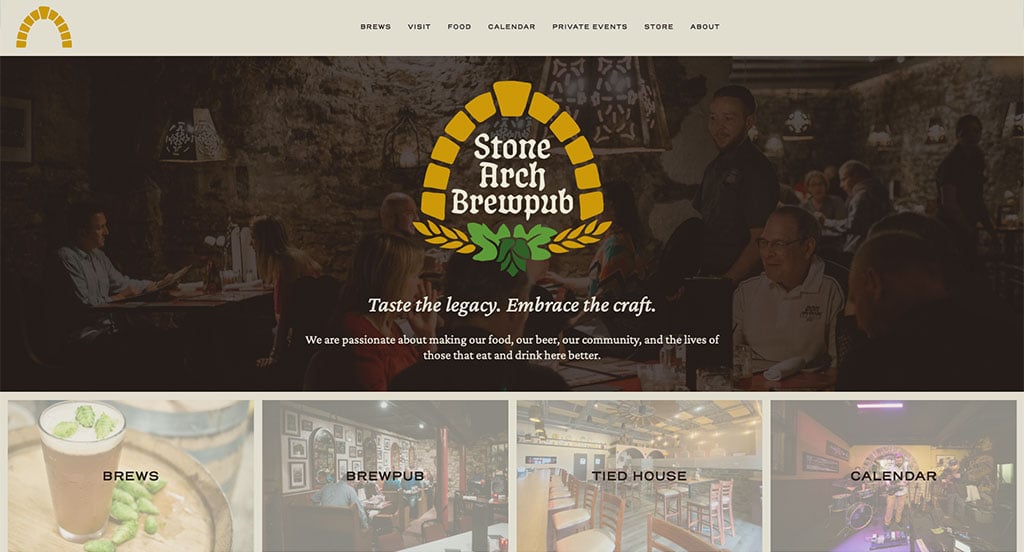
If you are a brewery looking for ideas for your next custom site, look no further than Stone Arch Brewpub. A relaxing color palette was definitely refreshing for a professional site like this one. Having organized sections within their site was something else that really helped it stand out from other competitor sites. From a marketing viewpoint, we liked how a simple but professional font was used. If you are looking for template examples for your next small business website, be sure to check this one out.
2. Threes Brewing
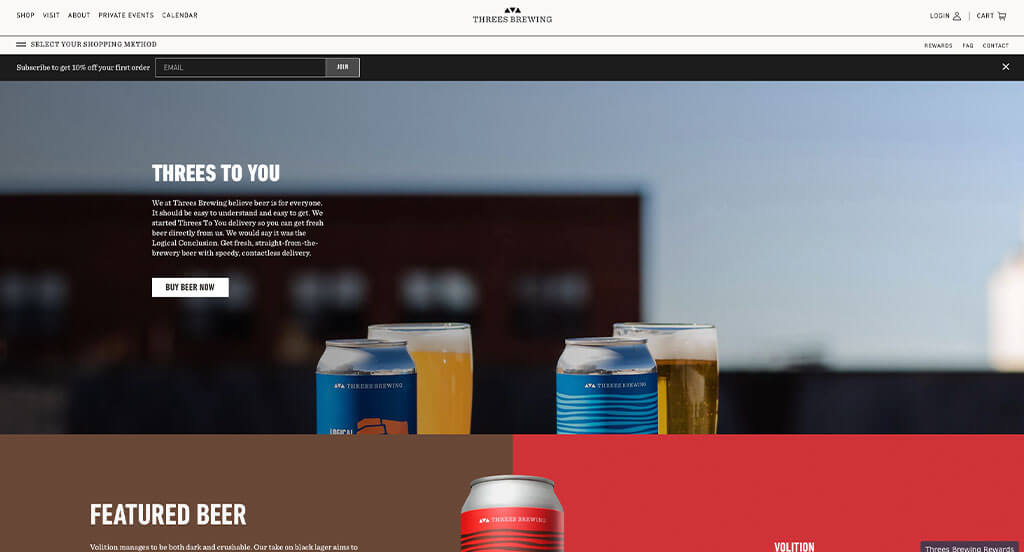
This is a good example of a website for a brewery that is looking for a custom look and feel for their next site. We thought this was a good homepage design example for breweries because of their color scheme that changes based on the images that are displayed. Their public events calendar was refreshing for a professional site. They clearly had website usability in mind when building the domain for their website that matches their company’s name. Be sure to consider the unique design of this brewery website when developing your next custom website.
3. Against The Grain Brewery

This is a good example of a website design for breweries looking for a professional website design. As you scroll through the homepage, one of the qualities you’ll notice right away is their colorful graphics. The inclusion of a blog was a unique choice for a professional brewery website. The navigation bar with organized categories within helped make this one of the top brewery websites we reviewed. Give some thought to the one-of-a-kind design of this brewery website when building your next website.
4. New Glarus Brewing Company
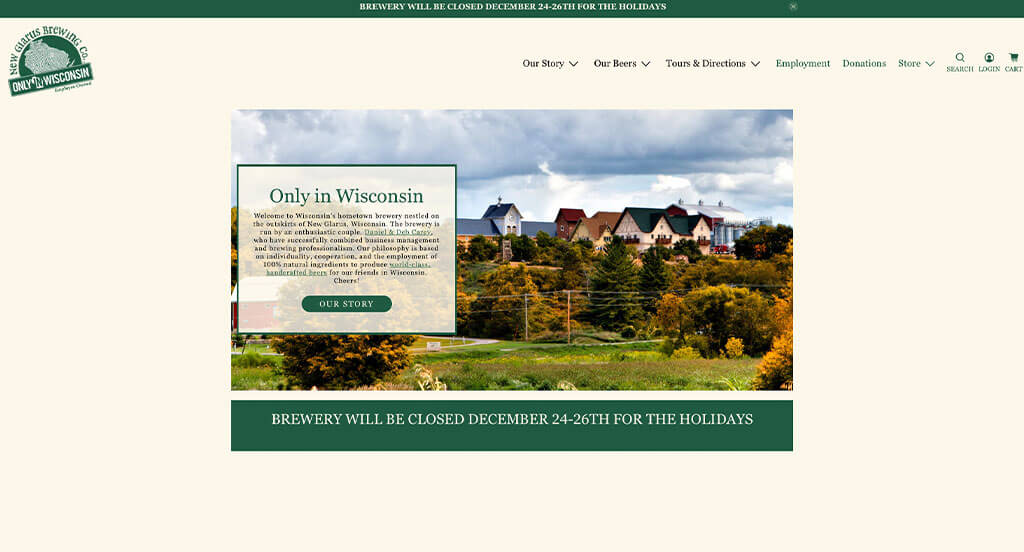
This is a great website design example for a brewery looking to pull inspiration for their next a custom website. As you scroll through the homepage, one of the design qualities you’ll see is the color scheme that matches the company’s logo design. The integration of social media was another feature in this professional brewery site we enjoyed. They clearly had ease of use in mind when designing the buttons seen throughout their website. For breweries looking for ideas on their next website, this example will definitely be one to keep in your back pocket.
5. Coors Light
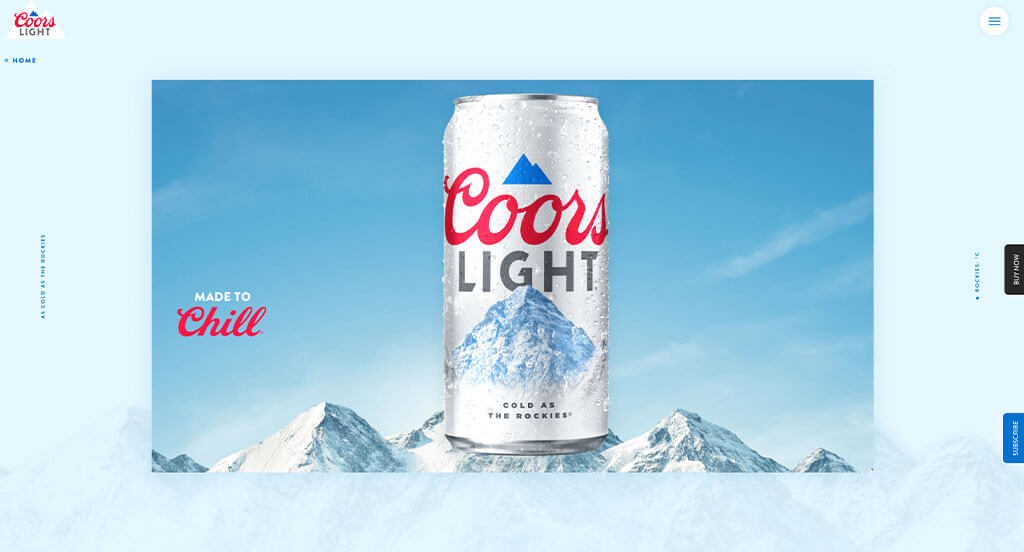
Coors Light has a great brewery website that uses blue, red, white and gray for a color scheme. As you scroll through the homepage of the website, one of the design qualities you’ll see is the graphic for their cans that matches the color scheme of their site. The repetition of their visuals was refreshing for a custom site. The fonts that are carried over to every page was one of the marketing features that really stood out when reviewing this website. These were just a few of the numerous qualities in this website we had to consider when putting together this list of top websites for breweries.
6. Lion’s Tail Brewing Co.
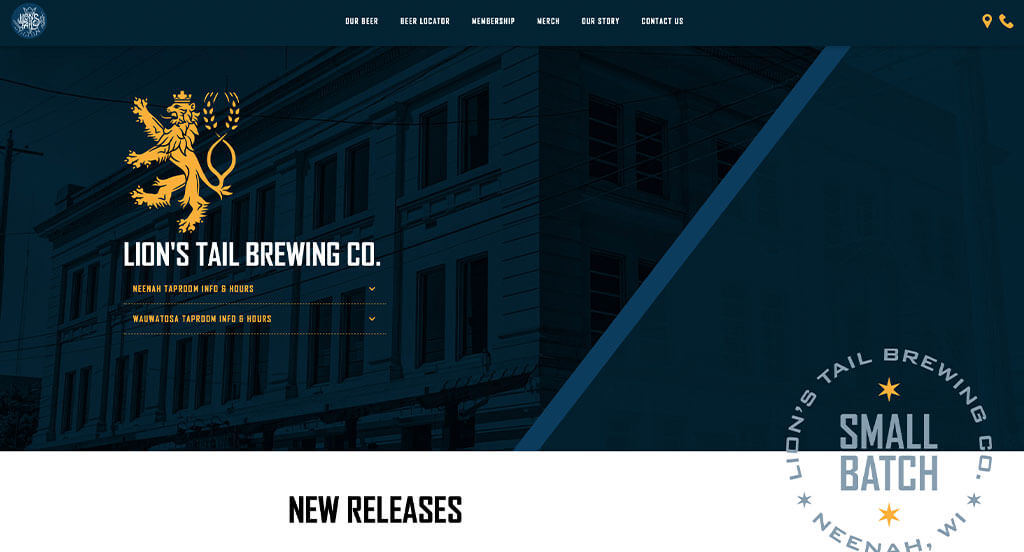
Lion’s Tail Brewing Co. has a great brewery website that uses dark blues, yellow and white to create a luxurious color scheme for their website. After scrolling past the header of this brewery site, you’ll immediately notice their logo seen all throughout the site. Their pages that look uniform throughout the site was definitely refreshing for a professional brewery site. Their well labeled navigation bar helped make this one of the best brewery websites we looked at. You won’t be disappointed after reviewing this website for design ideas for your next website!
7. The Dillon Dam Brewery
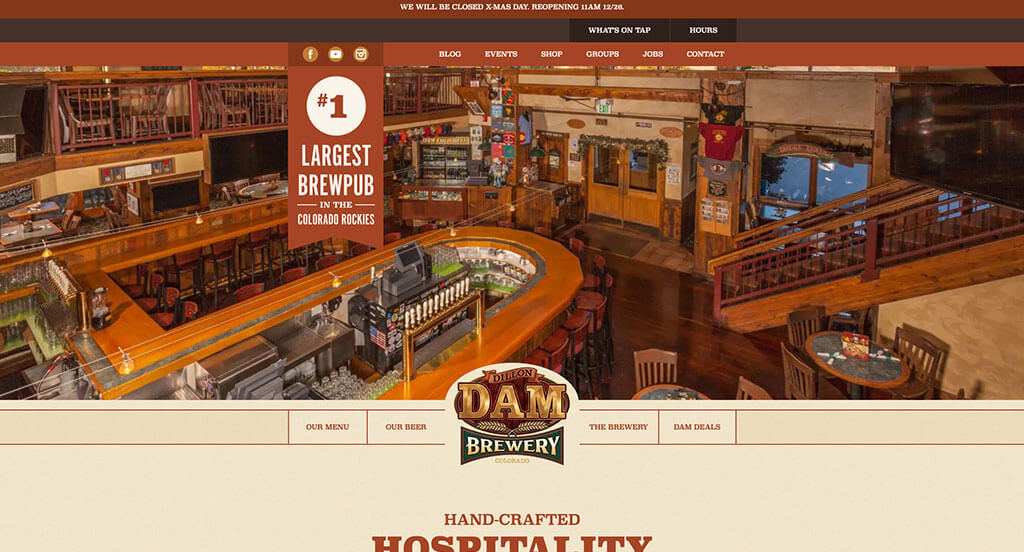
Sporting a clean and intuitive layout, this site keeps things simple for a brewery website. Our web designers thought this was a good example of a homepage layout for breweries because of their natural brown and tan color palette. Their wooden graphic used as a background for their online shop was definitely refreshing for a unique website. The Dillon Dam Brewery clearly had website accessibility in mind when creating the domain for their website that was similar to their company’s name. Any web designer developing websites for breweries will want to consider checking this website out.
8. Four Peaks Brewing Co.
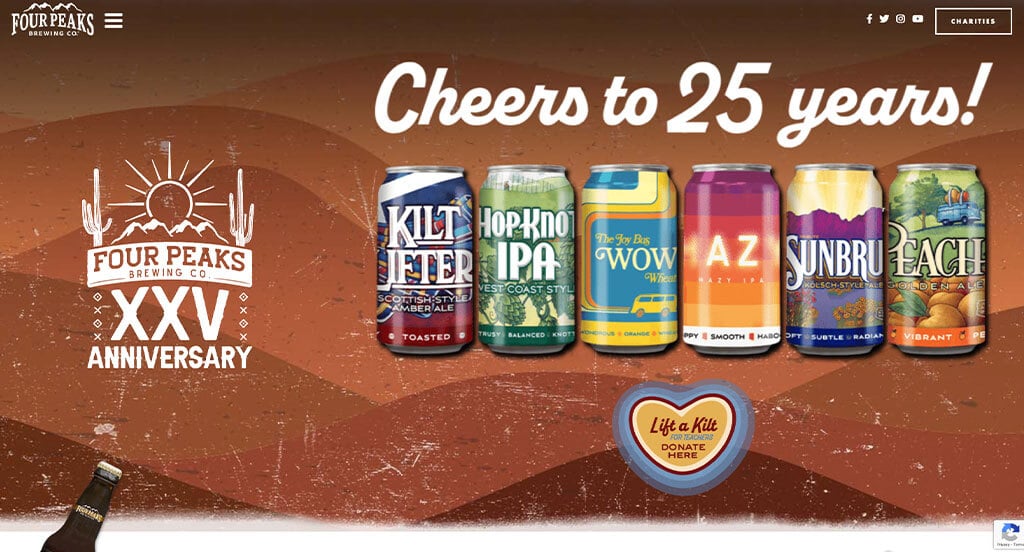
We immediately noticed the tan, browns and white used as a color scheme in the Four Peaks Brewing Co. website, which we liked because it makes sense for what their product is. We thought this was a good example of a homepage layout for breweries because of their large imagery. Another thoughtful quality in this clean brewery site was their menu with organized categories. They had conversions in mind when building the interesting logo design for their company. What a great website to review when building out your next brewery website!
9. Third Space Brewing
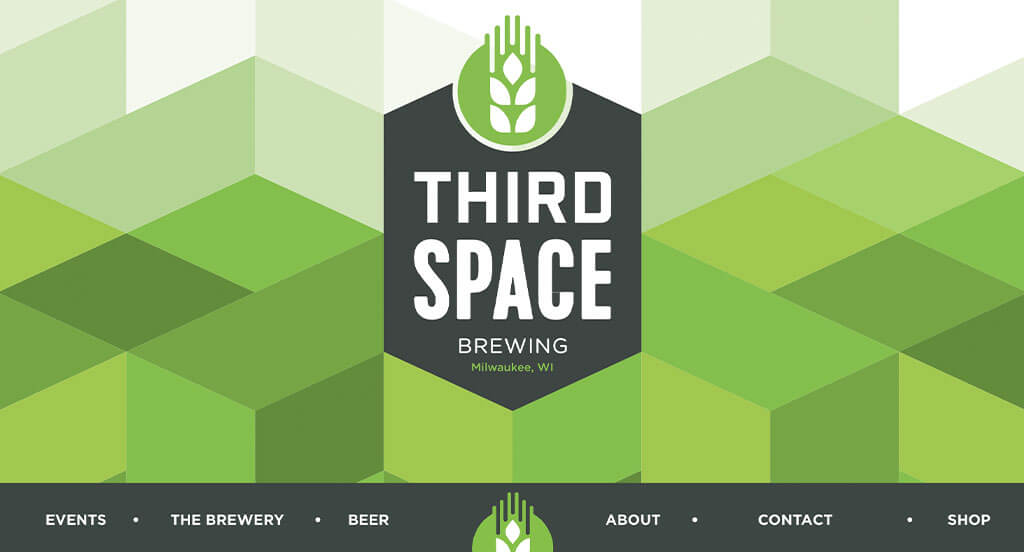
We liked how this brewery website used the colors of green, gray, white and a little blue to create a custom web design layout. Of all the custom brewery websites we reviewed, one of the features in this custom website we liked was the geometric pattern set as a backdrop at the top of the site. Another feature in this professional brewery site we enjoyed was the logo that was seen throughout the entire site. They had website marketing in mind when designing the stunning layout for their website. Be sure to consider the great design of this brewery website when developing your next custom website.
10. Southern Star Brewing Co.
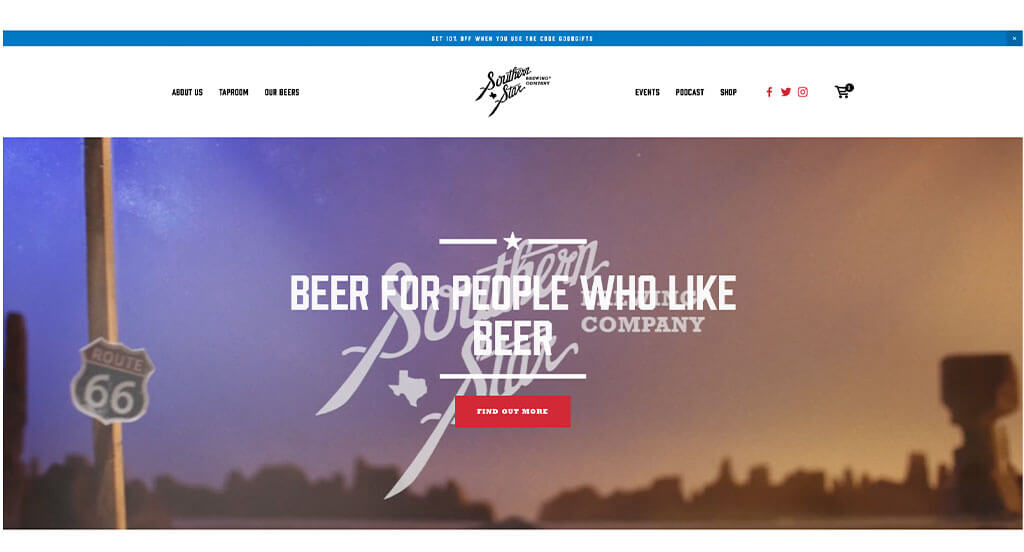
Southern Star Brewing Co. has a great looking website that uses a black, white and red color scheme. As you scroll through the homepage, one of the qualities you’ll notice right away is their logo that shows where the brewery is located. Another thoughtful quality in this clean brewery website was their favorites placed in a lineup. Southern Star Brewing Co. clearly had ease of use in mind when creating the simple navigation for their website. Don’t scroll past this website when considering design ideas for your next brewery website!
11. Archetype Brewing
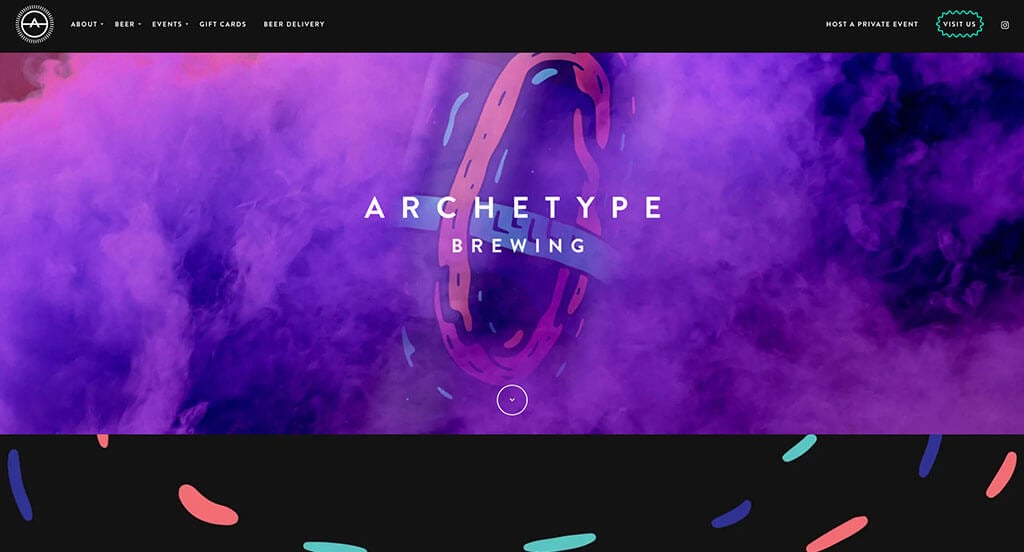
This is a great website design example for breweries who are looking for a custom layout. Of all the custom brewery websites we reviewed, one of the features in this custom website we liked was the dark colored background with bright colored graphics. Another thoughtful feature in this creative brewery site we noticed was the use of buttons to enhance usability. Their interesting logo design helped make this one of the top brewery websites we looked at. Give some thought to the unique design of this brewery website when developing your next custom website.
Related: Your brewery can implement an internet marketing plan to help increase awareness and build relationships in the local area.
12. DSSOLVR
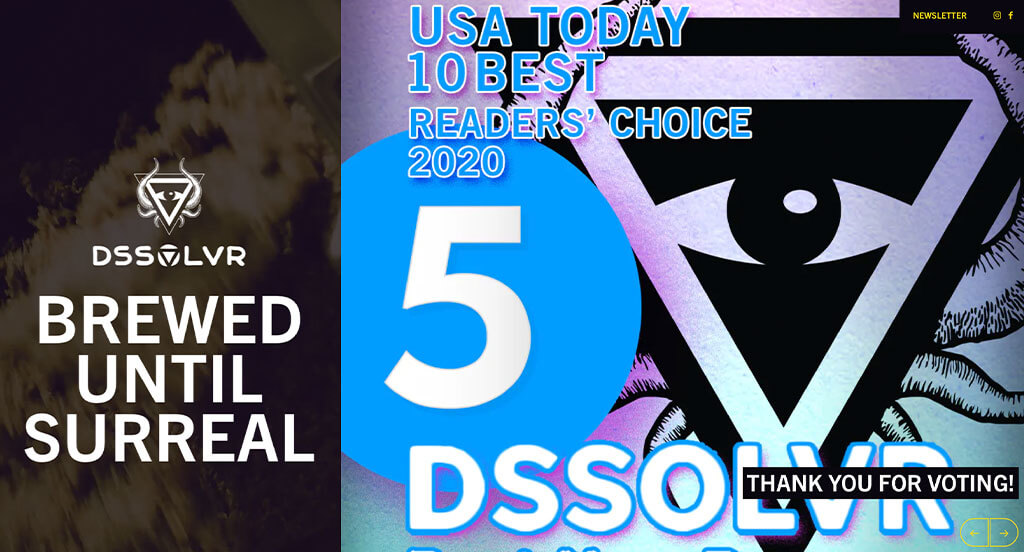
DSSOLVR has a great looking website that can inspire other breweries looking for ideas for their next custom website. After scrolling past the navigation of this brewery site, you’ll notice their unique graphics. Another design quality in this clean brewery site we liked was the integration of social media. They had website accessibility in mind when building the domain for their website that matches their company name. If you are looking for template options for your next brewery website, be sure to check this one out.
13. New Belgium Brewing
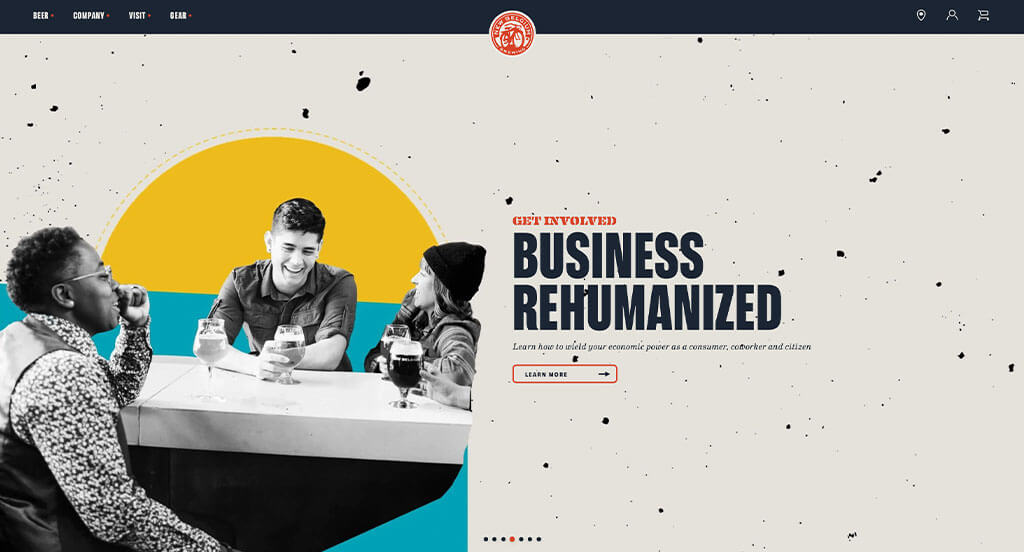
We liked how this brewery site combined the colors of white, blue, yellow, red and black into an attractive website layout. Our web designers thought this was a good homepage design example for breweries because of the creative fonts. The clearly labeled menu was refreshing for a unique site. They clearly had internet marketing in mind when creating the interesting logo design for their website. For breweries who are looking for examples for their next website layout, this design example will absolutely be one to keep in your back pocket.
14. Lexington Brewing & Distilling Co.
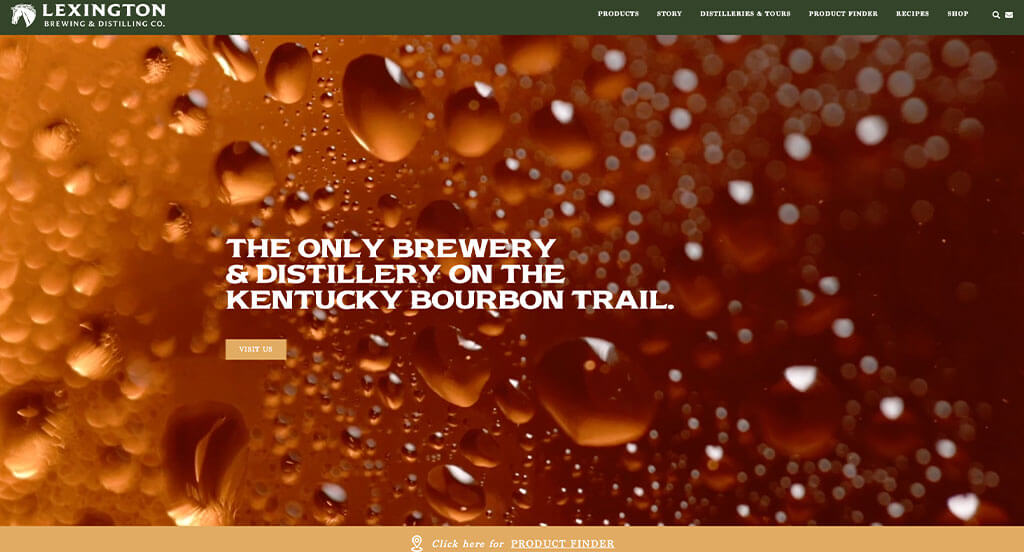
The white, green and yellow colors used in this brewery website stood out to us because it creates a clean design. The captivating font was definitely the most impactful feature we noticed in the homepage of this website. The buttons for simple navigation was refreshing for a unique brewery site. The domain for their website that was similar to the company’s name helped make this one of the top brewery websites we considered. What a great website to review when building out your next website!
15. Camden Town Brewery
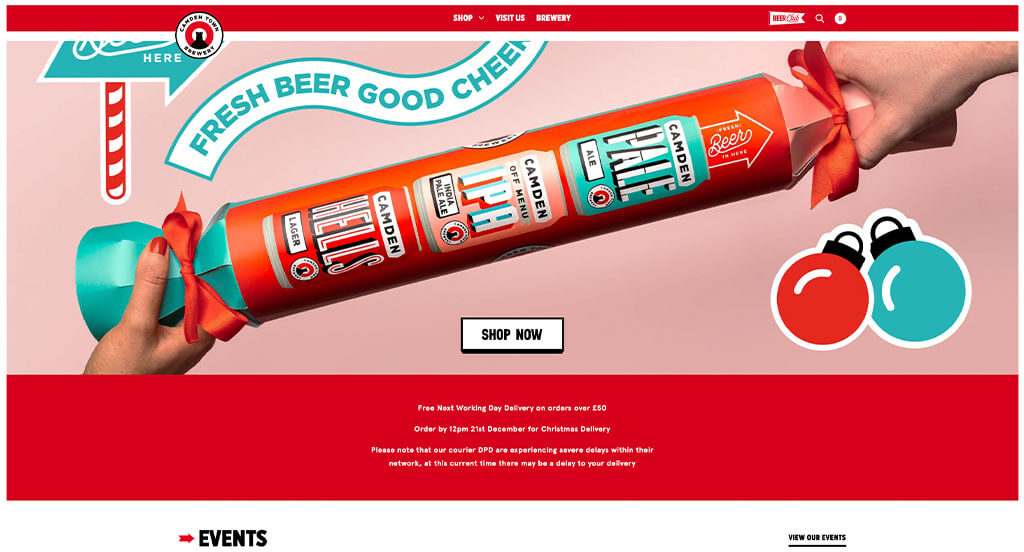
The website of Camden Town Brewery ranked because it’s one of the better looking brewery websites we came across. While most brewery websites share this quality, we thought Camden Town Brewery did a nice job of red, dark blue white and black color scheme seen throughout the site. The interesting logo was absolutely a consideration when ranking Camden Town Brewery in this list of the best brewery websites. Camden Town Brewery had ease of use in mind when designing the creative graphics used throughout their website. These were just a few of the numerous amazing qualities in this website we had to consider when putting together this list of top websites for breweries.
16. Gnarly Cedar Brewing
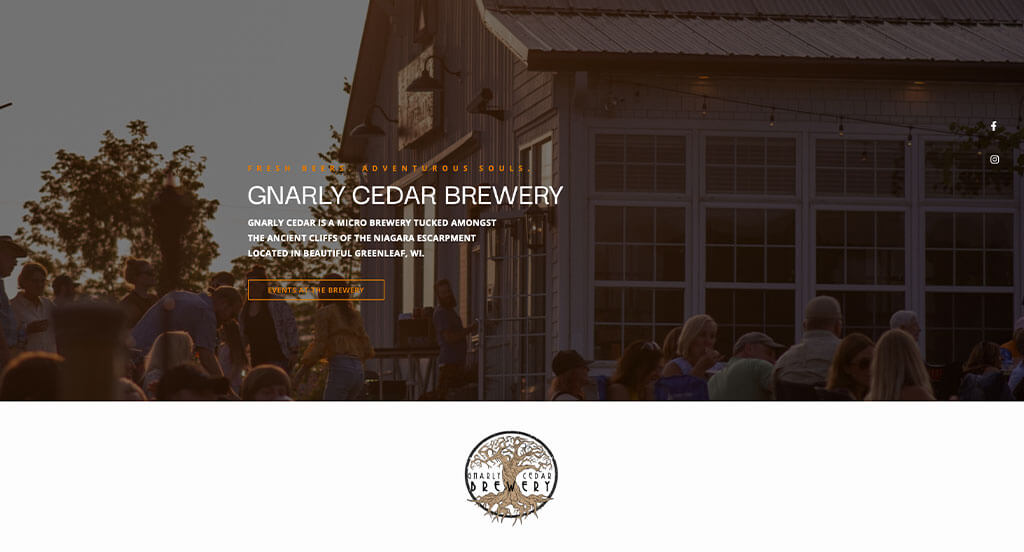
We appreciated how this brewery site used the colors of white, brown, orange and black to create an attractive website layout. As you scroll through the homepage of the website, one of the design qualities we liked was the logo design that fits the company’s name. Another thoughtful feature in this custom brewery website we liked was the layout with a good balance of white space. They had website marketing in mind when creating the smooth transitions for their website. You won’t be disappointed when reviewing this website for design ideas for your next website!
17. Flying Monkeys Craft Brewery
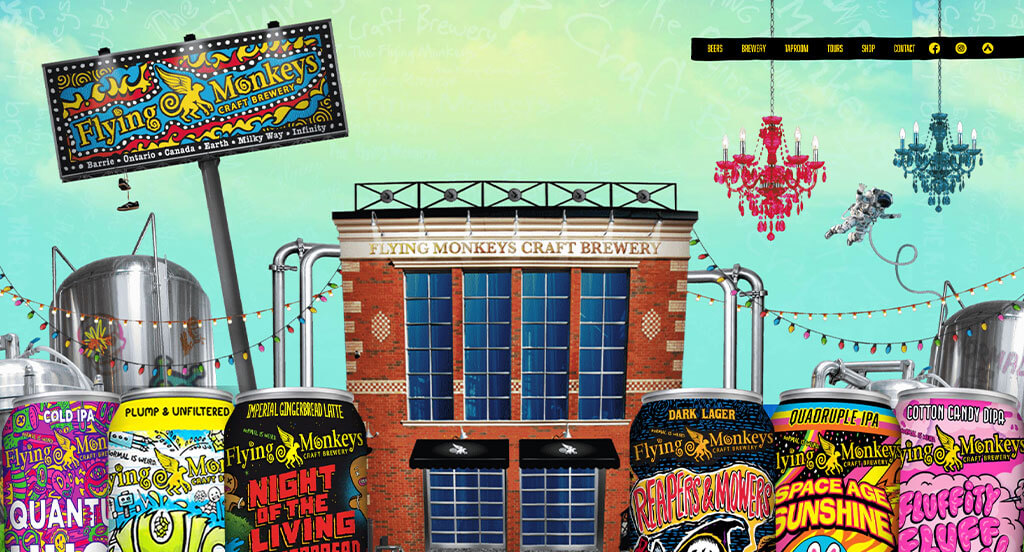
The variety of colors used in the color palette of this brewery site stood out to us because it has a sense of organized chaos. The subtle animations were probably the most impactful quality in the homepage of this website. This professional brewery site also does a good job with the interesting graphics to match their color scheme. They clearly had a focus on website marketing when building the template that seems authentic to their website. Be sure to consider the one-of-a-kind design of this brewery website when building your next website.
18. Blind Enthusiasm Brewing
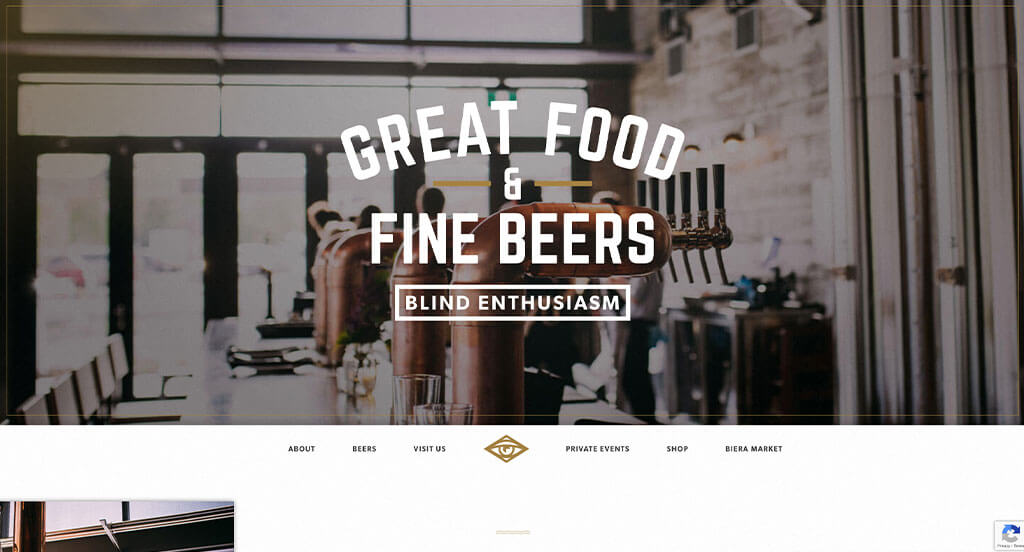
Showcasing a clean and intuitive layout, this site keeps things simple for a brewery website. Our web designers thought this website was a good example for breweries because of their color scheme that builds a strong backdrop. The well labeled navigation bar was a nice touch for a custom website. They clearly had website marketing in mind when creating the thoughtful logo design for their website. Don’t forget to check this website out while looking through our list of the best brewery websites!
19. Fate Brewing Company
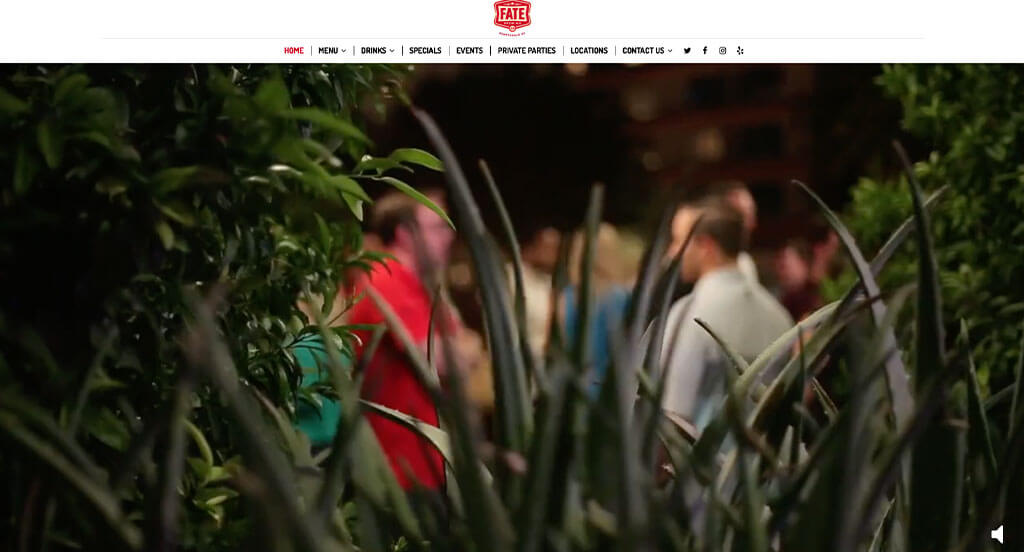
Fate Brewing Company has a great looking website that generally uses a neutral color scheme, which we liked because it allows the images to defend the mood of the page. The automatically playing video was likely the most impactful quality in the homepage of this website. Another design quality in this clean brewery website we noticed was the texture to the edges of their color blocks. Fate Brewing Company clearly had a focus on digital marketing when building the simple navigation throughout their website. For breweries looking for examples for their next website layout, this design example will absolutely be one to take a look at.
20. Founders Brewing Co.
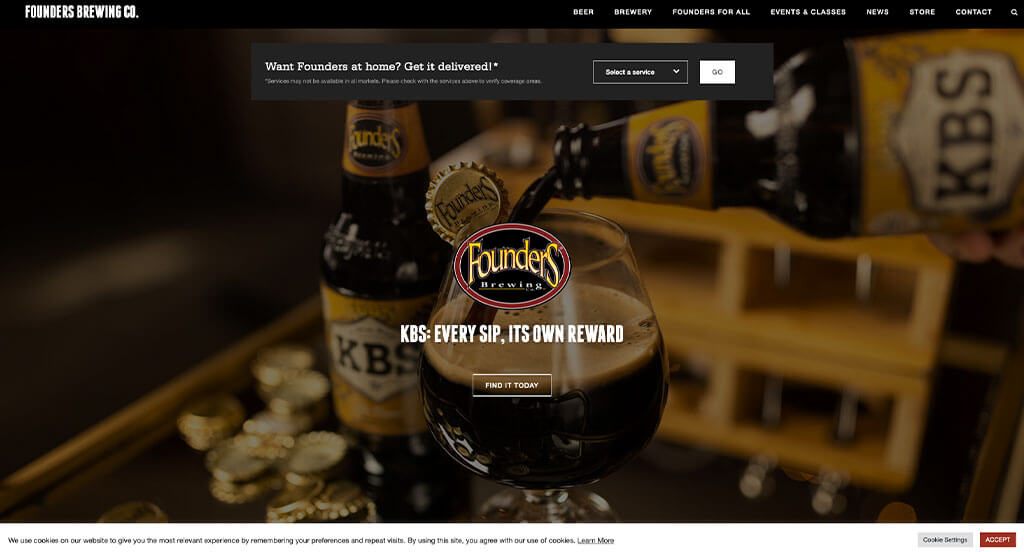
We appreciated how this brewery site used the colors of black, white, red and yellow to create an attractive website design. As you scroll through the homepage of this website, one of the design qualities you’ll see is the variety of font sizes. The incorporation of social media in this website helped it make it into our list of the best websites layouts for breweries. They clearly had a focus on ease of use when creating the domain for their website that matches their company name. Any website designer making websites for breweries will want to consider checking this website out.
21. Reuben’s Brews
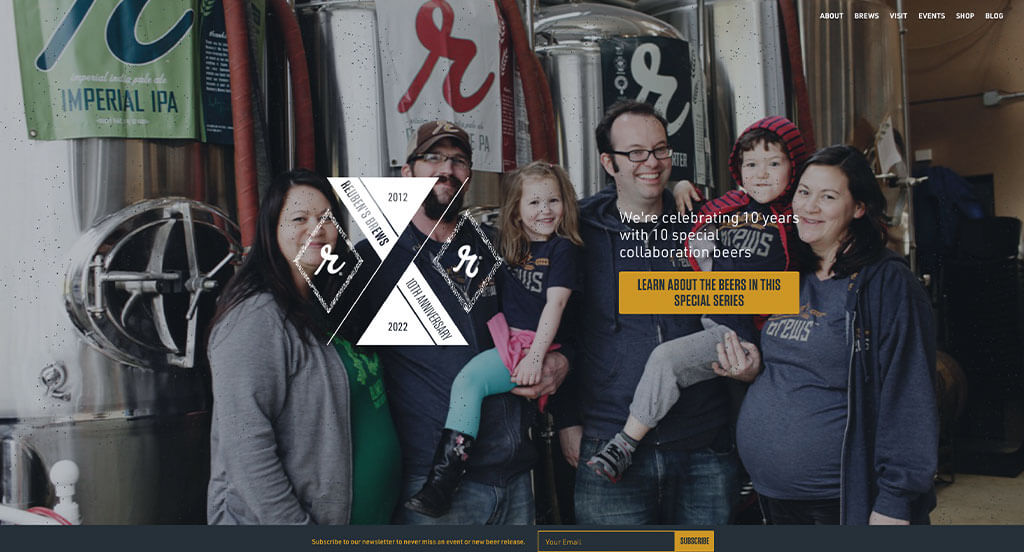
This is a good example of a design for breweries who are looking for a custom look and feel for their next site. Our web designers thought this website was a good example for breweries because of their large display of their beverages offered. This custom brewery website also does a good job with the graphics to show their breweries at different locations. They clearly had a focus on conversations when building the variety of events taken place at their location. If you are looking for template ideas for your next brewery website, be sure to check this one out.
22. Sierra Nevada Brewing Co.
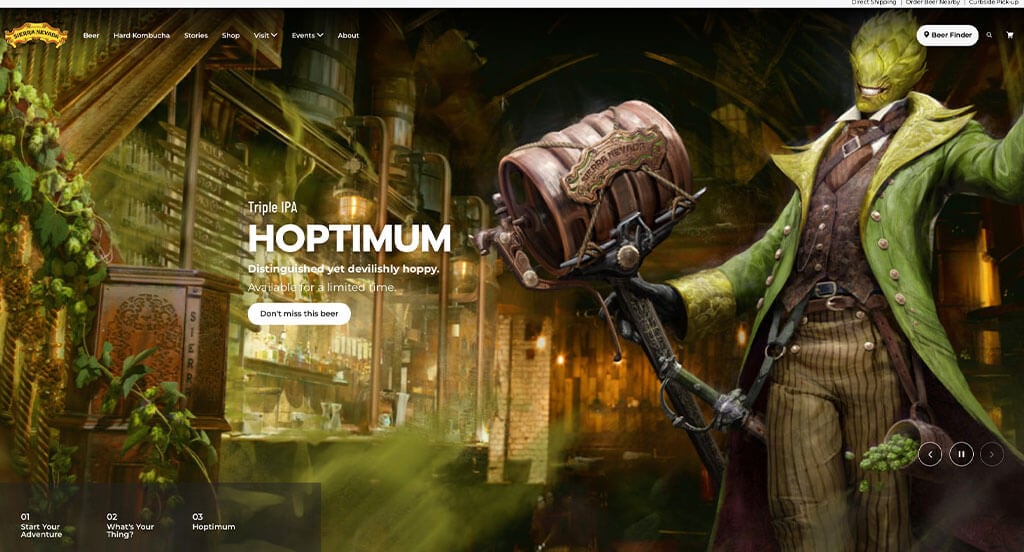
This is a great example for breweries to check out when looking for a professional look and feel for their next website. After scrolling past the header of this brewery site, you’ll notice their outdoorsy color palette. Their smooth transitions were another reason why we included this site in our rankings for the top web design ideas for breweries. Sierra Nevada Brewing Co. had ease of use in mind when building the navigation bar with organized categories for their website. Give some thought to the unique design of this brewery website when developing your next custom website.
Related: Have something unique and special at your establishment? Maybe think about implementing a paid advertising campaign to drive awareness.
23. Bell’s Brewery
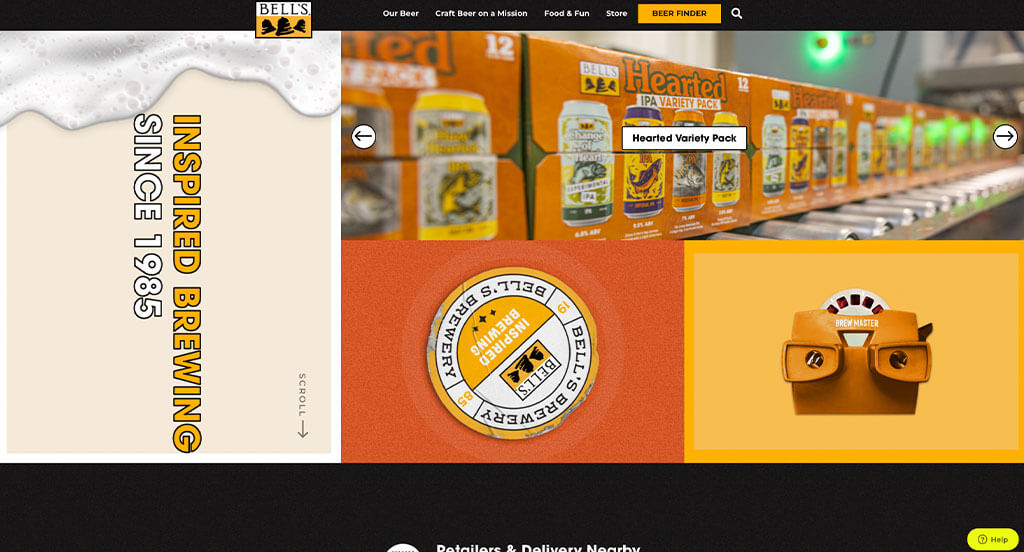
The website of Bell’s Brewery ranked because it’s one of the nicer brewery websites we reviewed. Of all the custom breweries we reviewed, one of the features in this custom website we liked was their flashy banners drawing attention to their ID section. The subtle animations were definitely refreshing for a unique site. Bell’s Brewery clearly had a focus on ease of use when building the fun graphics appearing as stickers in their website. Talk about a great website to have included in this list of top websites!
24. Stone Brewing
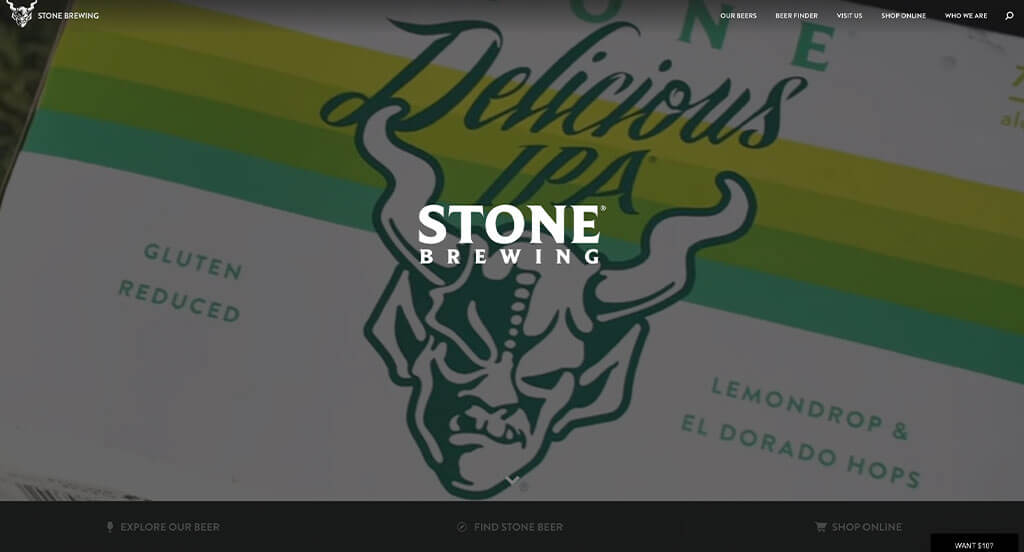
This is a good website example of a website design for breweries who are looking for a custom site design. The layout of this brewery website was thoughtful because of their creative display of their featured beers. The use of their gargoyle logo throughout the site was another design quality in this custom brewery site we enjoyed. Stone Brewing clearly had a focus on conversions when building the well labeled navigation bar for their website. These were just a few of the qualities in this website we had to consider while we were putting together this list of top websites for breweries.
25. Driftwood Brewery
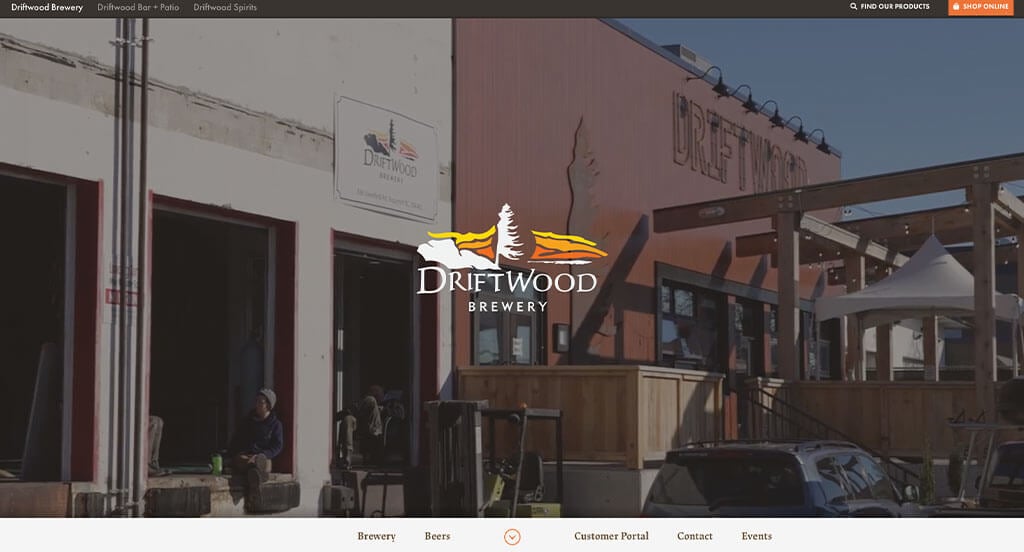
Sporting a clean and intuitive layout, this site keeps things simple for a brewery website. Of all the custom breweries websites we reviewed, one of the features in this custom website we liked was the brown, white, black, orange and yellow color scheme. The creative logo design used in this website helped it make it into our list of the best website layouts for breweries. Driftwood Brewery had website accessibility in mind when building the buttons to enhance usability throughout their website. You won’t be disappointed after reviewing this website for design ideas for your next website!
26. Reformation Brewery
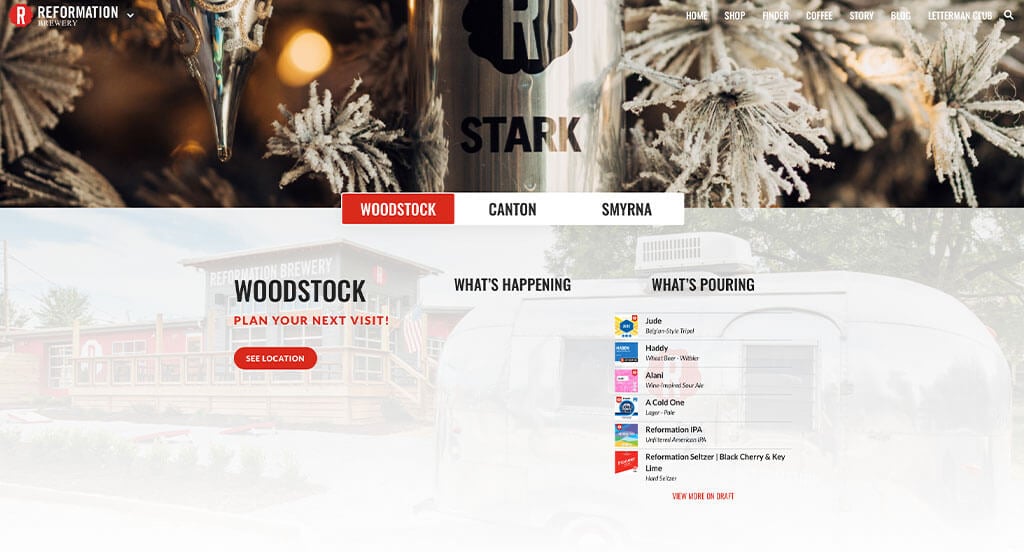
The Reformation Brewery website has a very classy feel to it, thanks to its unique use of red, white and black. After scrolling past the header of this brewery site, you’ll immediately notice the ability to see upcoming events and hours for each location. The clearly labeled menu was another feature in this custom brewery website we enjoyed. Reformation Brewery clearly had a focus on conversions when designing the domain for their website that matches the company name. Be sure to consider the one-of-a-kind design of this brewery website when developing your next website.
27. Avondale Brewing Company
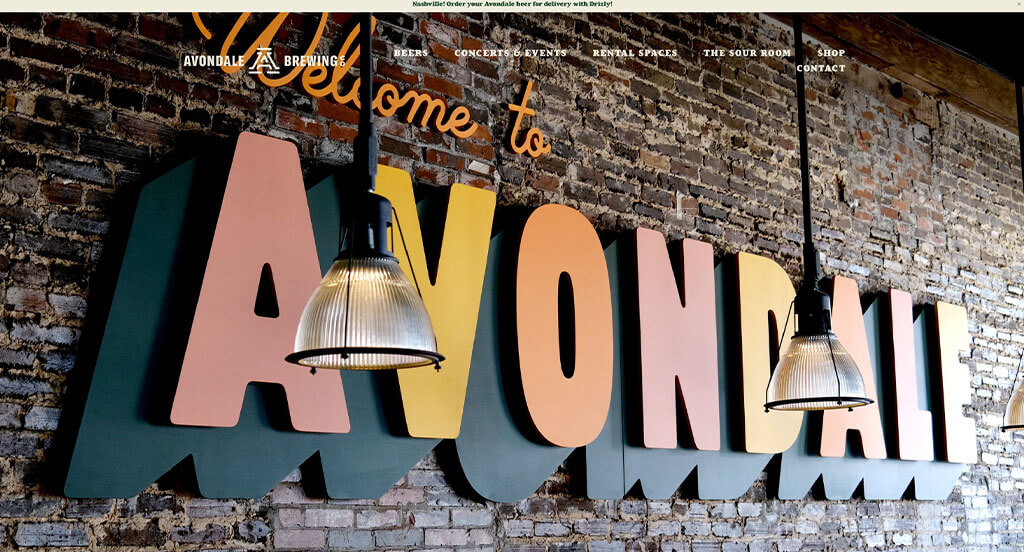
Avondale Brewing Company has a great looking website that uses a unique color scheme, which we like because it’s unexpected but still looks good together. As you scroll through the homepage, one of the design qualities we liked was the large fonts used throughout the site. Another feature in this clean brewery website was their display of their golf simulator. Avondale Brewing Company clearly had a focus on digital marketing when creating the use of buttons to enhance usability in their website. For breweries who are looking for ideas on their next website, this example will definitely be one to take a look at.
28. Iron City Beer
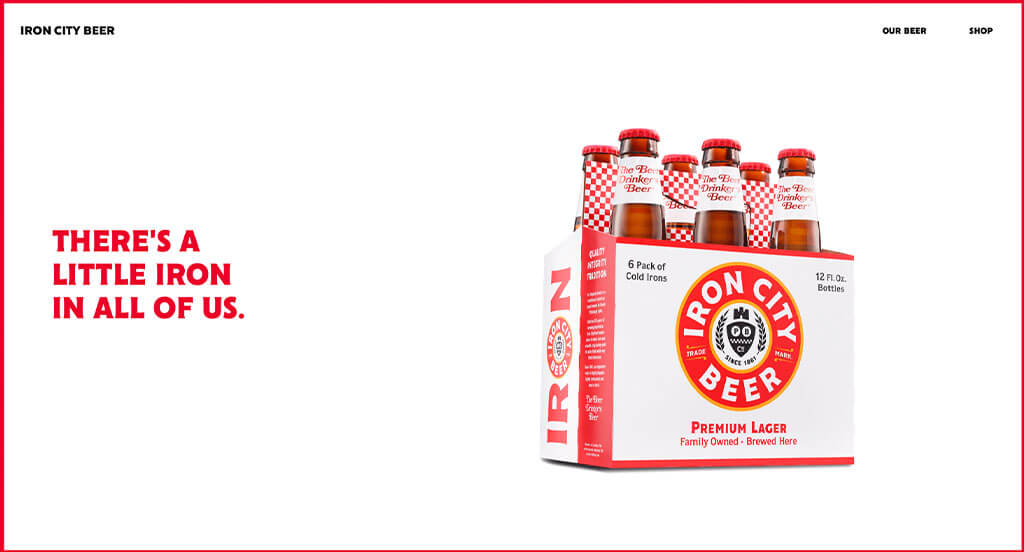
This is a great website example for breweries who are looking for a custom look and feel for their next site. After scrolling past the header of this brewery site, you’ll immediately notice the smooth transitions. The captivating font was another thoughtful feature in this professional brewery site we enjoyed. Iron City Beer clearly had a focus on website marketing when creating the elaborate logo for their website. Give some thought to the great design of this brewery website when developing your next custom website.
29. Goldwater Brewing Co.
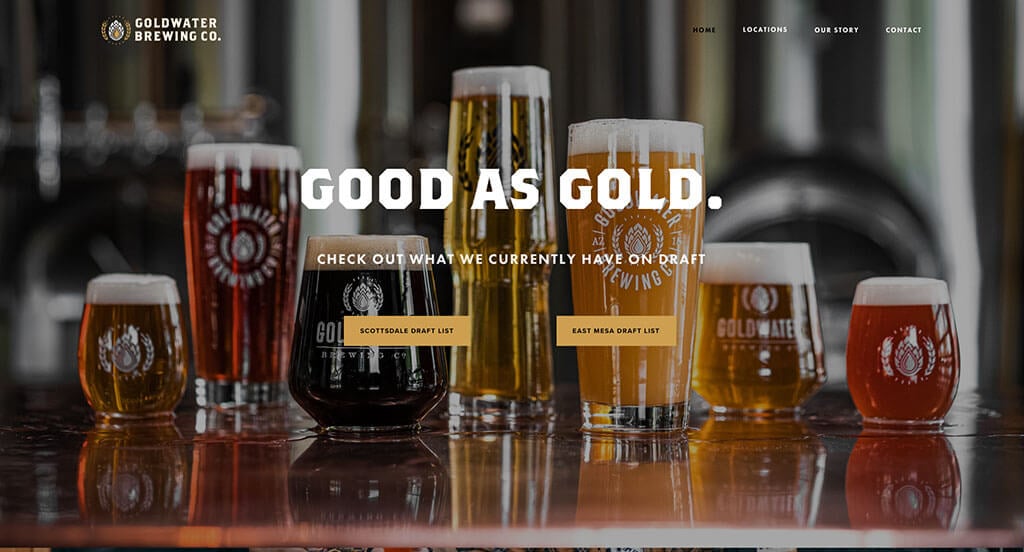
We appreciated how this brewery website used the colors of black, white and gold to create a custom web design. As you scroll through the homepage of this website, you;ll be able to tell what state they are based out of. The integration of social media was definitely refreshing for a unique site. Goldwater Brewing Co. clearly had a focus on conversions when designing the thought provoking logo for their website. What a great website to review when designing your next website!
30. Royal Oak Brewery
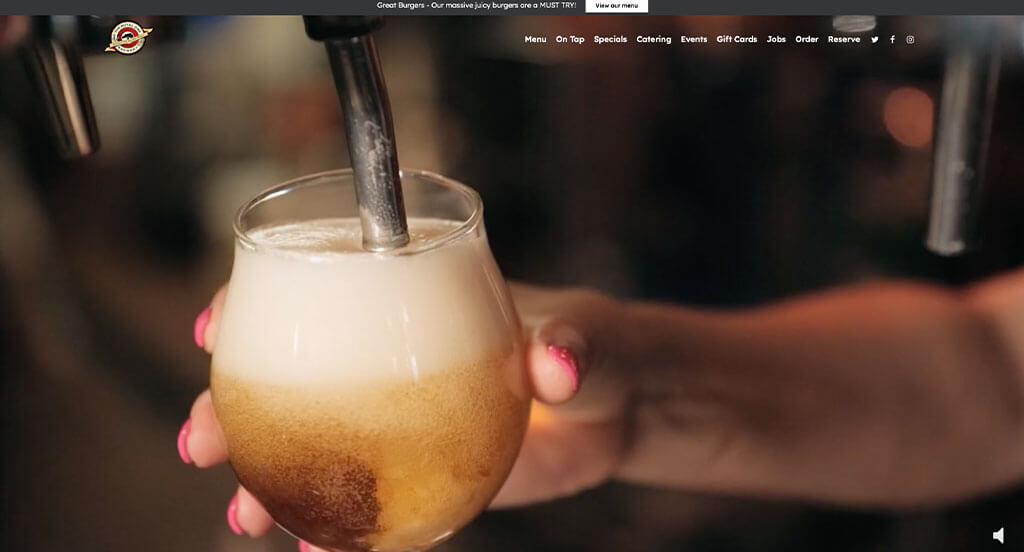
The Royal Oak Brewery website has a very classy feel to it, thanks to its unique use of red, black, white, yellow and cream. The high-quality visuals were probably the most impactful quality in the homepage of this website. This creative brewery site also does a good job with the display of their food as well as their beer. They clearly had internet marketing in mind when creating the customer review section for their website. Don’t forget to check this website out while looking through our list of the best brewery sites!
31. Two Chefs Brewing
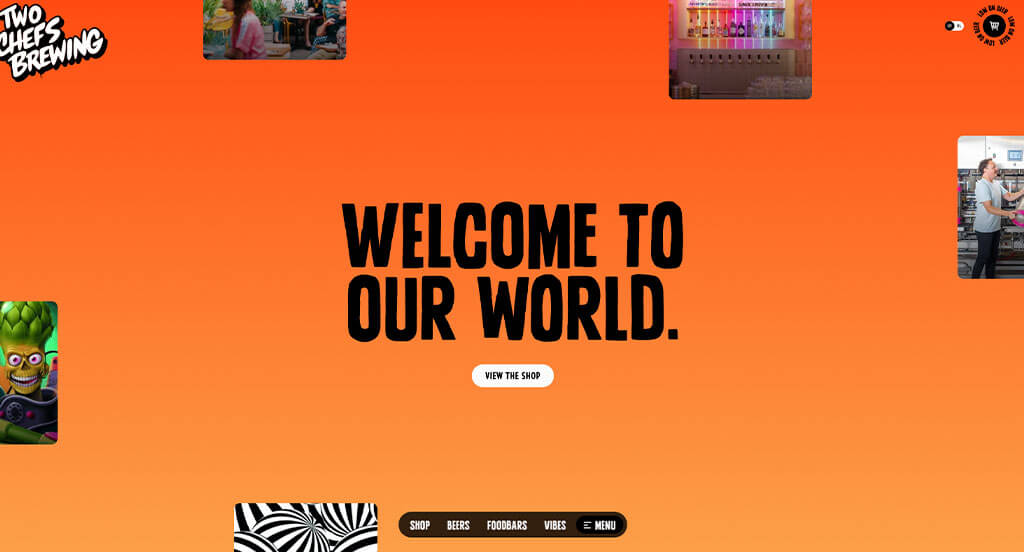
This is a good example of a website design for breweries to check out when looking for a professional website design. One of the homepage features in Two Chefs Brewing we noticed was the bold color scheme because that isn’t something you find on most brewery websites. The variety of font sizes was absolutely a consideration when ranking Two Chefs Brewing in this list of the most professional brewery websites. They clearly had a focus on ease of use when creating the domain for their website that matches the company name. If you are looking for template ideas for your next brewery site, give some thought to this one.
32. The Ale Apothecary
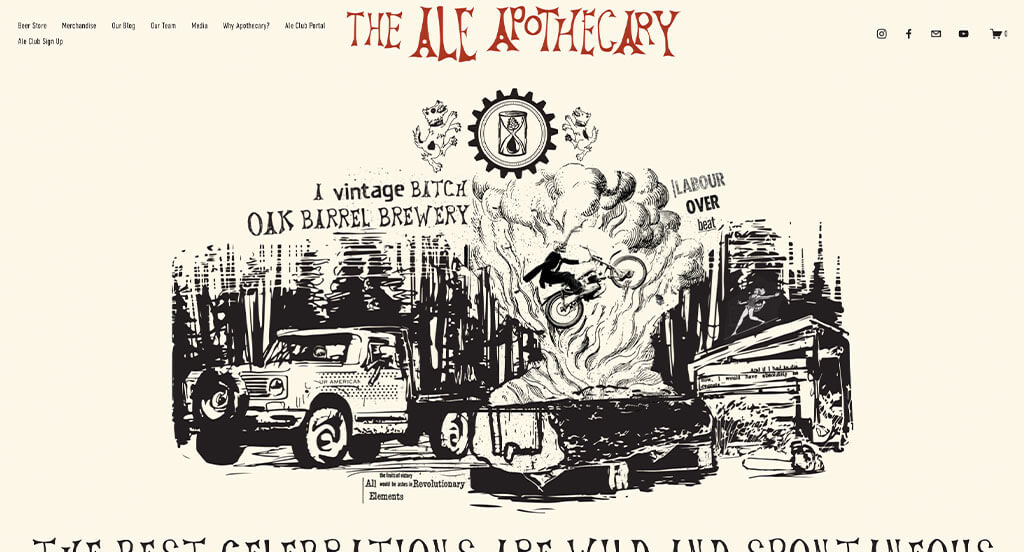
The simple color palette used in this custom brewery site stood out to us because it feels relaxing. As you scroll through the homepage, you’ll notice the stunning imagery. The clearly labeled menu was another unique quality in this custom brewery website we enjoyed. They clearly had website usability in mind when creating the layout with a good balance of white space for their website. Talk about a great website to have included in this list of top websites!
33. Upland Brewing Co.
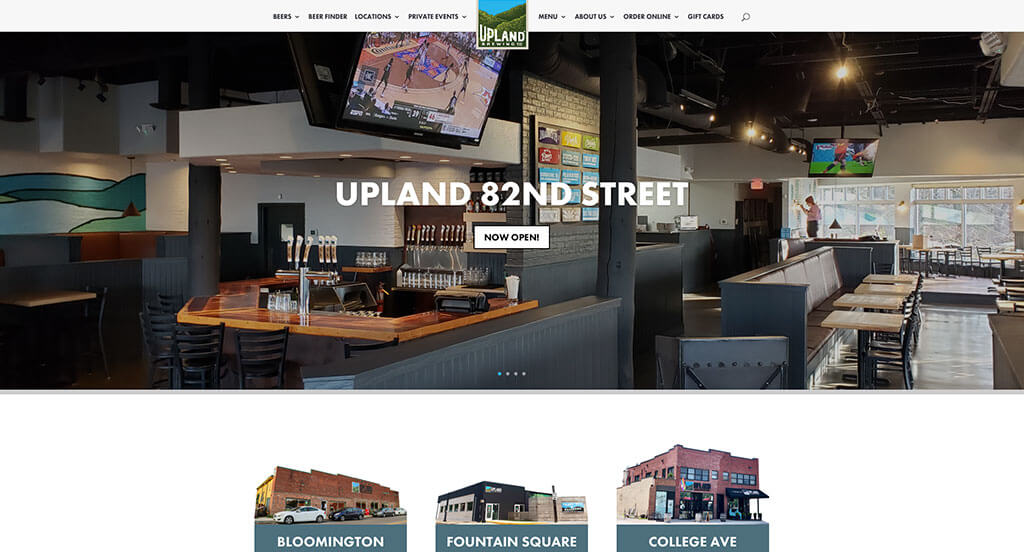
Showcasing a clean and intuitive layout, this site keeps things simple for a brewery website. After scrolling past the navigation of this brewery site, you’ll immediately notice their navigation bar with organized categories. Another thoughtful quality in this creative brewery website was their menu of their beers organized by location. Upland Brewing Co. clearly had website marketing in mind when designing the template for their website that was free of distractions in their website. Be sure to consider the one-of-a-kind design of this brewery website when developing your next website.
34. Samuel Adams
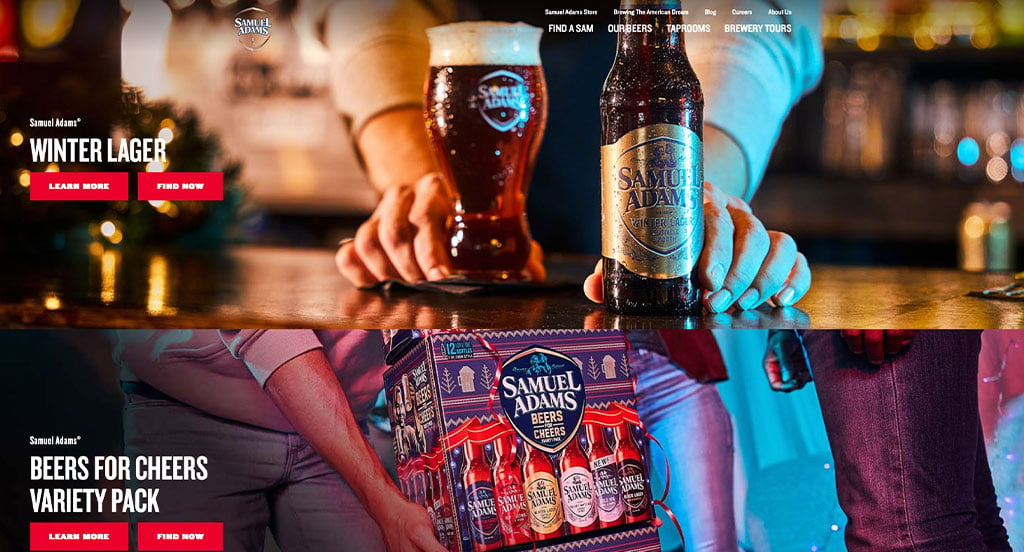
This is a good example of a web design for breweries who are looking for a custom website. Of all the professional brewery websites we reviewed, one of the features in this custom website we liked was the large imagery. The bright colored buttons to ensure simple navigation was a nice touch for a unique brewery website. Samuel Adams clearly had website marketing in mind when creating the blog for their website. For breweries looking for examples for their next website layout, this design example will absolutely be one to keep in your back pocket.
35. Fifth Ward Brewing
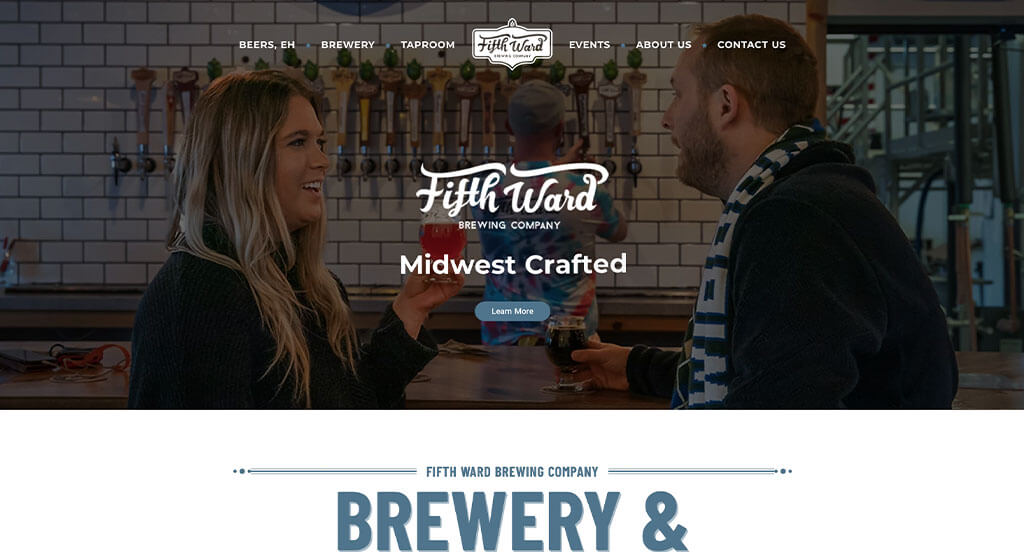
For a brewery website, this site did a great job utilizing the white, blue, black and gray colors throughout their site. As you scroll through the homepage of this website, one of the qualities you’ll notice right away is their creative logo that was displayed throughout the site. The variety of different sized fonts used appropriately was refreshing for a professional brewery website. Fifth Ward Brewing clearly had a focus on marketing when designing the creative graphics printed on their canse. Another amazing website to add to this list!
36. Fort Point Beer Company
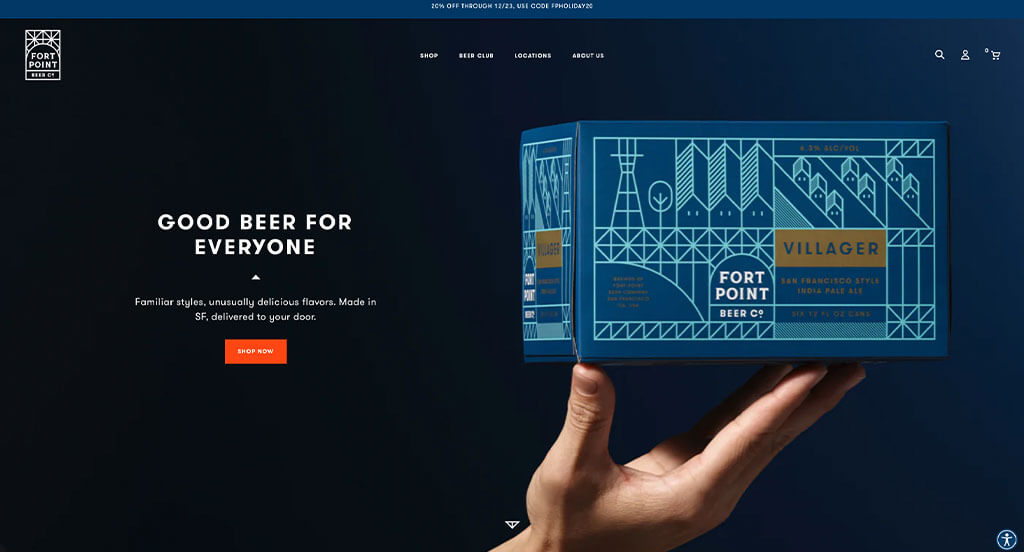
This is a great web design example for breweries who are looking for a professional website design. The template that was calming and creative was definitely the most impactful quality in the homepage of this website. This custom brewery site also does a good job with their incorporation of social media. They clearly had a focus on digital marketing when designing the interesting logo design for their website. Give some thought to the great design of this brewery website when building out your next website.
37. Abnormal Co.
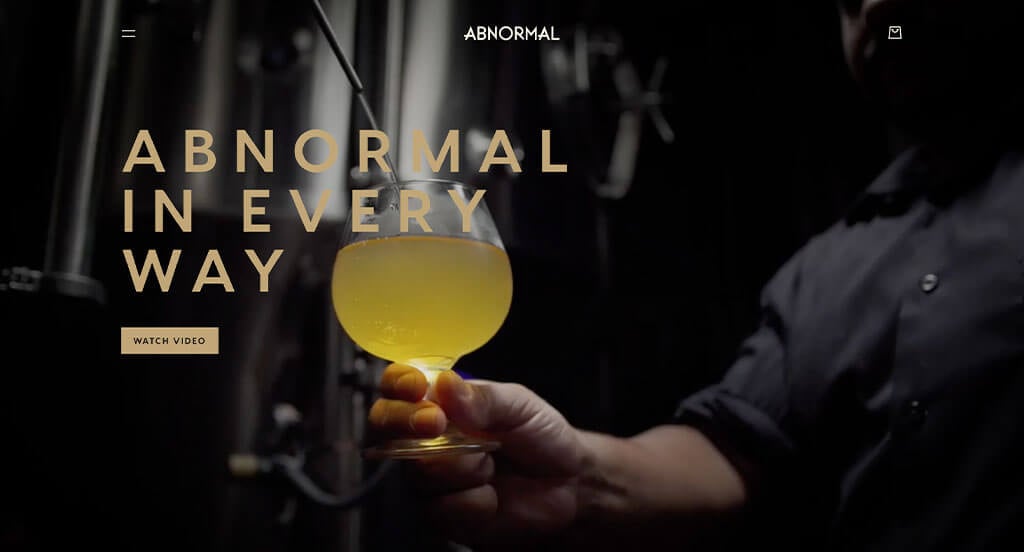
This is a good example of a brewery website design to check out when looking for a professional website layout idea. After scrolling past the header of this brewery website, you’ll immediately notice the automatically playing video. The short phrase seen when opening their menu was another reason why we included this website in our rankings for the top web design ideas for breweries. Abnormal Co. had digital marketing in mind when designing the ability to turn the website from light to dark viewing. With so many quality reasons to consider this brewery website, it’s no wonder we included it in this list of the best sites!
38. Milwaukee Brewing Co.
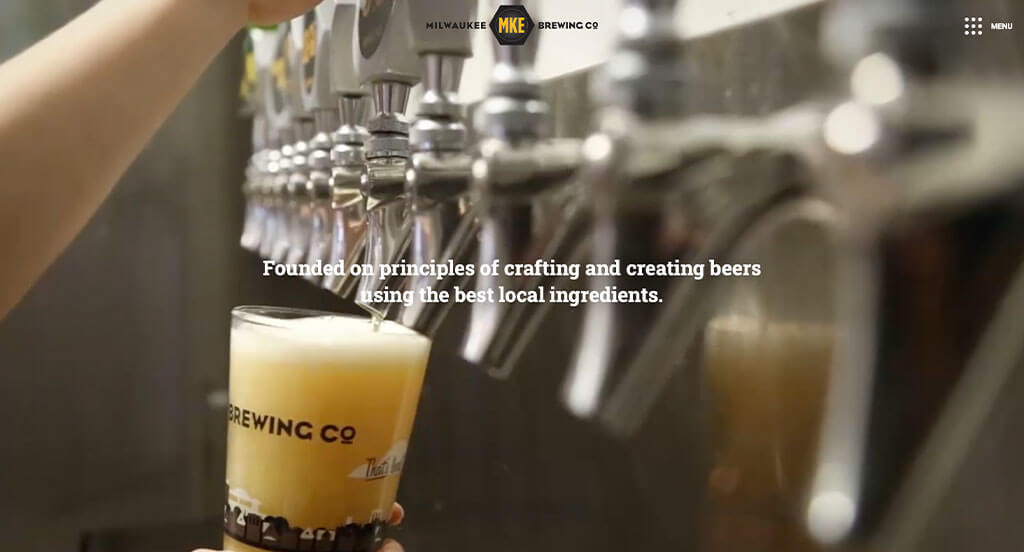
Milwaukee Brewing Co. has a great brewery website that uses yellow, navy blue and white for a color scheme. As you scroll through the homepage, one of the qualities you’ll notice right away is their beer finder so viewers can find their favorites in stores, restaurants and more. The membership page that shows exactly what you’d be getting with their membership was a good choice for a unique brewery site. Milwaukee Brewing Co. had internet marketing in mind when building the thoughtful font choice for their website. So many attractive qualities to consider when ranking this website.
Related: Are people looking for breweries in your local area? If so, you’ll want to fight to get first page placements. Don’t let other breweries get all the business in town!
39. PHX Beer Co.
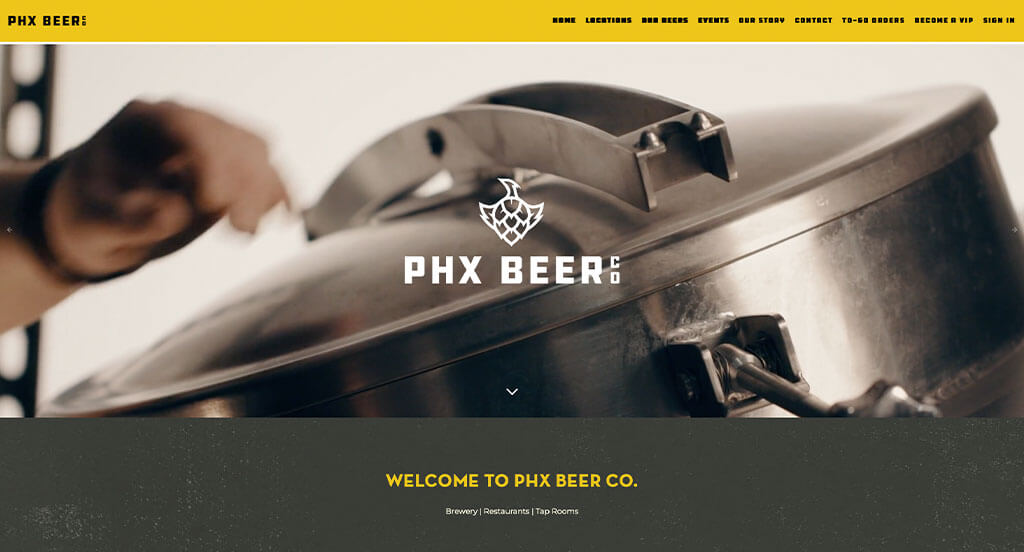
This is a good example of a brewery’s website design for someone who is searching for a professional website design idea. After scrolling past the navigation of this brewery site, you’ll notice their use of large images for backgrounds. The clearly labeled menu was another unique quality in this custom brewery website we enjoyed. Their use of videos throughout the site helped make this one of the best brewery websites we reviewed. Be sure to consider the unique design of this brewery website when developing your next website.
40. Lagunitas Beer
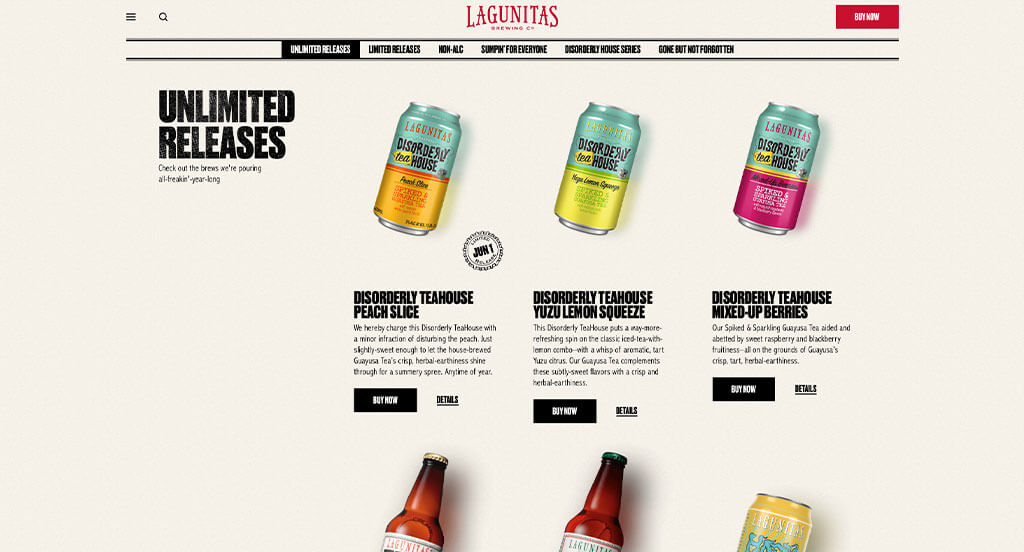
This is a good example of a brewery website design to check out when looking for inspiration for a professional looking website. After scrolling past the navigation of this brewery website, you’ll immediately notice the cream colored background that feels less formal than other sites. The reappearing dog that seems to be their mascot was absolutely a consideration when ranking Lagunitas Beer in the list of top brewery websites. They had website usability in mind when designing the bold font for titles within their website. If you are looking for template ideas for your next brewery site, give some thought to this one.
41. Hopewell Brewing Co.
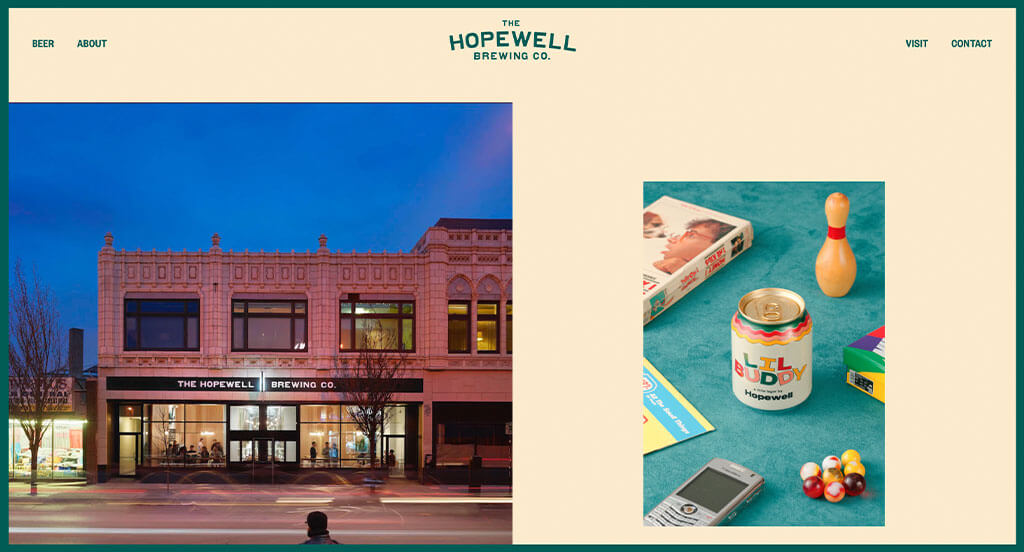
This is a good example of a brewery website design that can provide inspiration to other companies for a professional website. The unique frames for some of their imagery was likely the most impactful feature in the homepage of this website. The creative color scheme was refreshing for a custom site. They clearly had a focus on ease of use when designing the domain for their website that matches their company’s name. For breweries who are looking for examples for their next website layout, this example will for sure be one to keep in your back pocket.
42. Good Robot Brewing
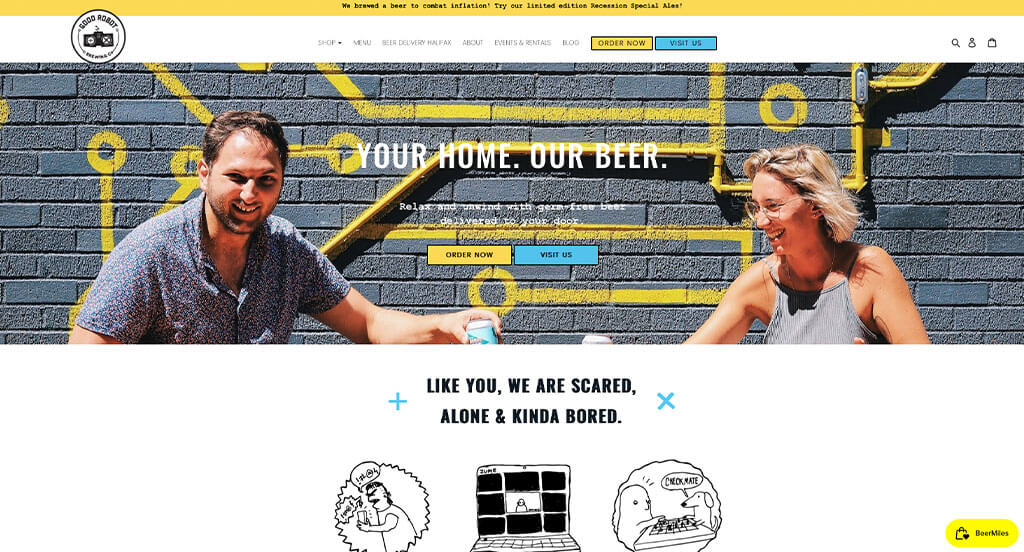
43. Heineken
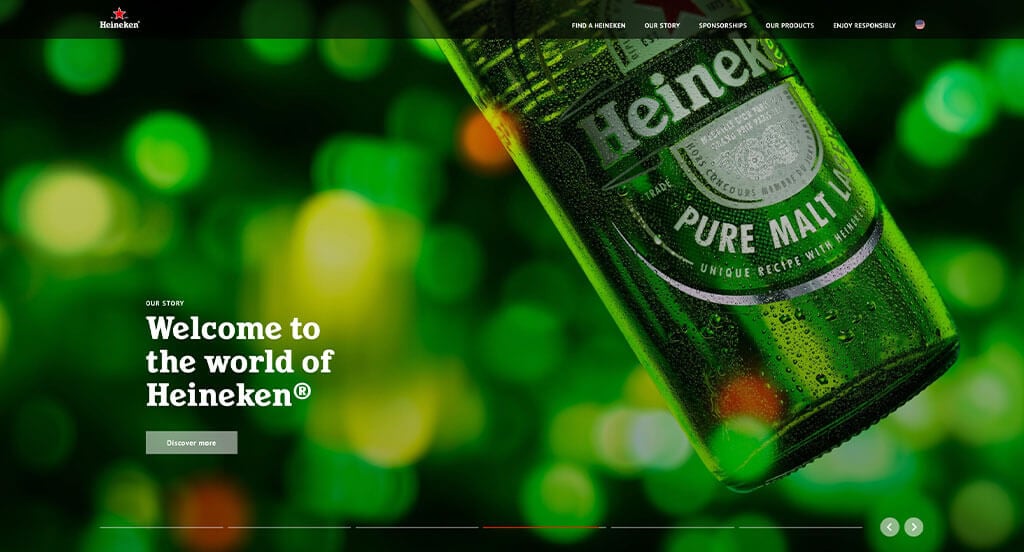
This is a great website example for breweries who are looking for a custom look and feel for their next site. The color scheme that creates a nice unity throughout the site was probably the most impactful quality in the homepage of this website. The simple logo design was refreshing for a custom brewery site. From a marketing perspective, we liked the way this website utilized a clearly labeled menu. Give some thought to the creative design of this brewery website when developing your next website.
44. Brooklyn Brewery
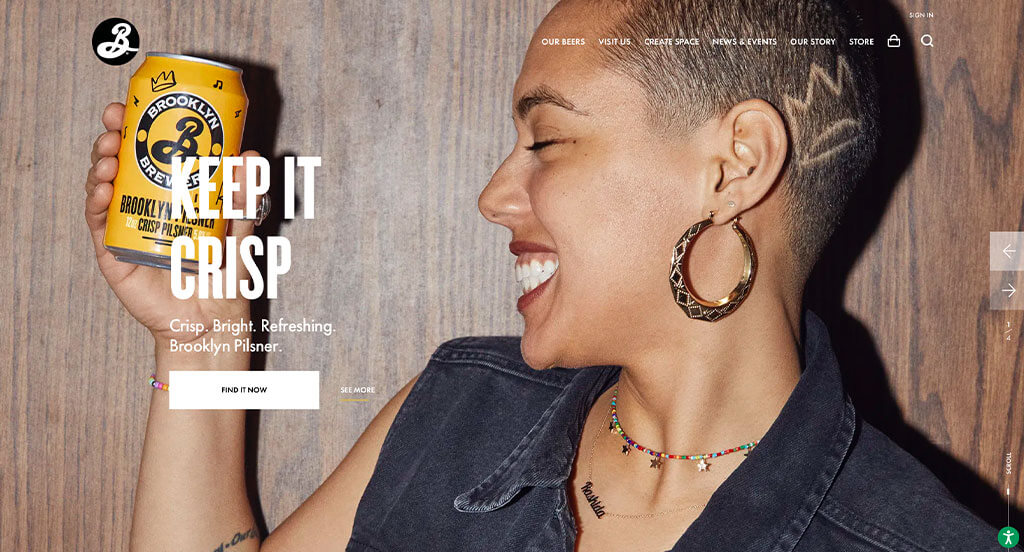
There were a lot of breweries to choose from, but Brooklyn Brewery was a great example of a nicely organized website with a gray, green, white and black color scheme. One of the homepage features in Brooklyn Brewery we noticed was their use of alternating color blocks because that isn’t something you find on most brewery websites. Their well balanced layout was another reason why we included this website in our list of the best template ideas for breweries. From a marketing point of view, we really liked the way this brewery website utilized a well labeled navigation bar. Any website designer building websites for breweries will want to consider checking this website out.
45. McFleshman’s Brewing Co.
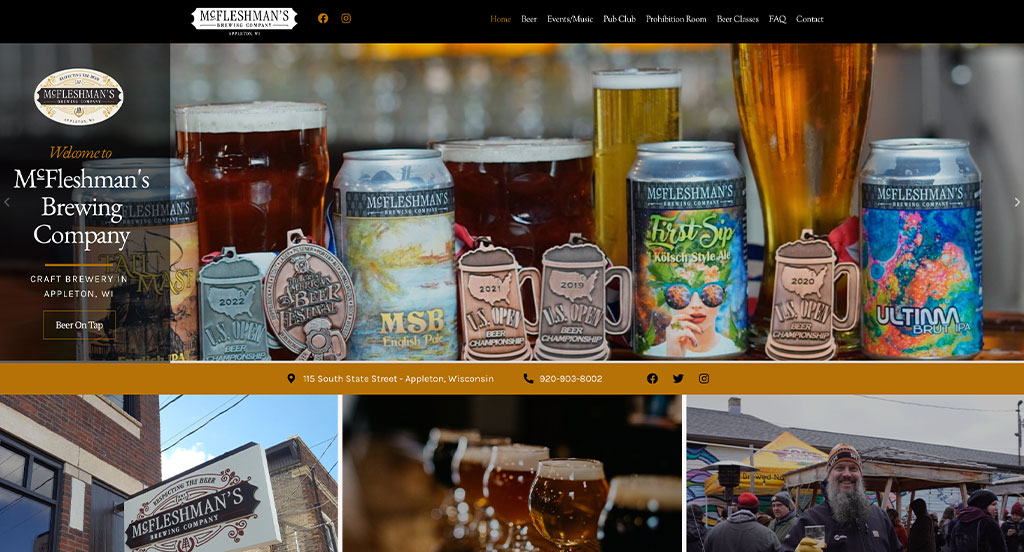
Our web designers noticed the black, white and orange color scheme used in the McFleshman’s Brewing Co. website, which we liked because it creates an emotion that reminds viewers of bars. The most refreshing part of this brewery website was their professional imagery. The inclusion of social media was refreshing for a professional brewery website. They clearly had ease of use in mind when building the frequently asked questions section for their website. What a great website to review when building out your next website!
46. Tin Roof Brewing Co.
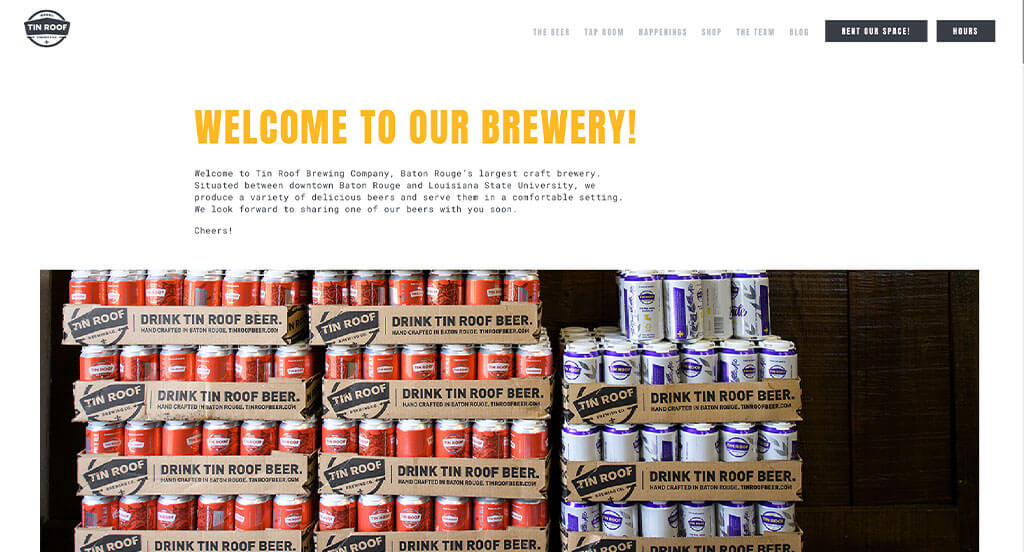
This is a great website example for breweries who are looking for a custom site layout. Our web designers thought this was a good example of a homepage layout for breweries because of their thoughtful logo design. The simple color scheme was another reason why we included this website in our list of the best layouts for breweries. They had ease of use in mind when designing the easily accessible shop within their website. Don’t forget to check this website out while looking through our list of the best brewery sites!
47. STL Beer
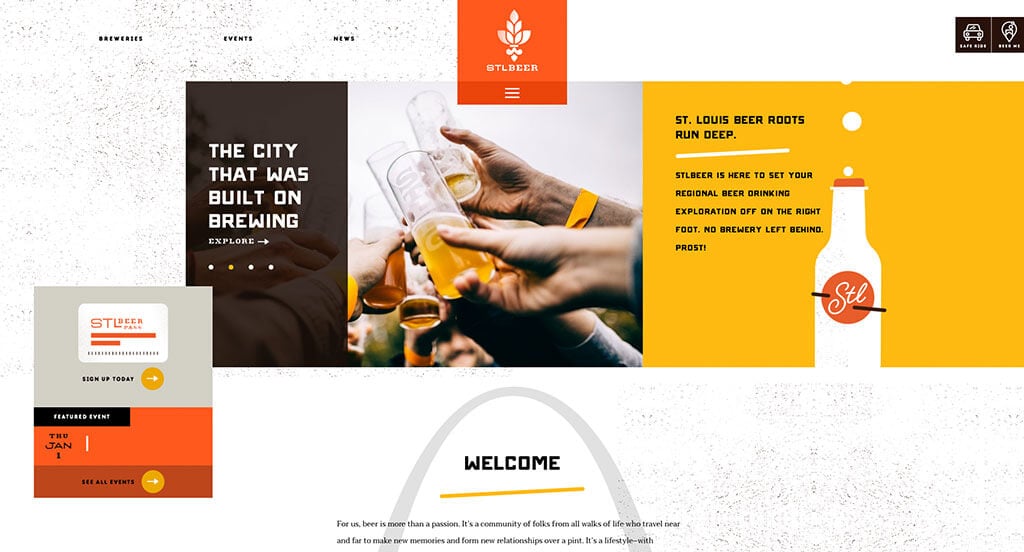
We liked how this brewery site combined the colors of white, yellow, orange and black to create an attractive website layout. After scrolling past the navigation of this brewery website, you’ll immediately notice the texture added onto their background. This creative brewery website also does a good job with their subtle animations throughout the site. STL Beer clearly had website marketing in mind when building the simple contact information for their website. Be sure to consider the great design of this brewery website when developing your next custom website.
48. Lakefront Brewery
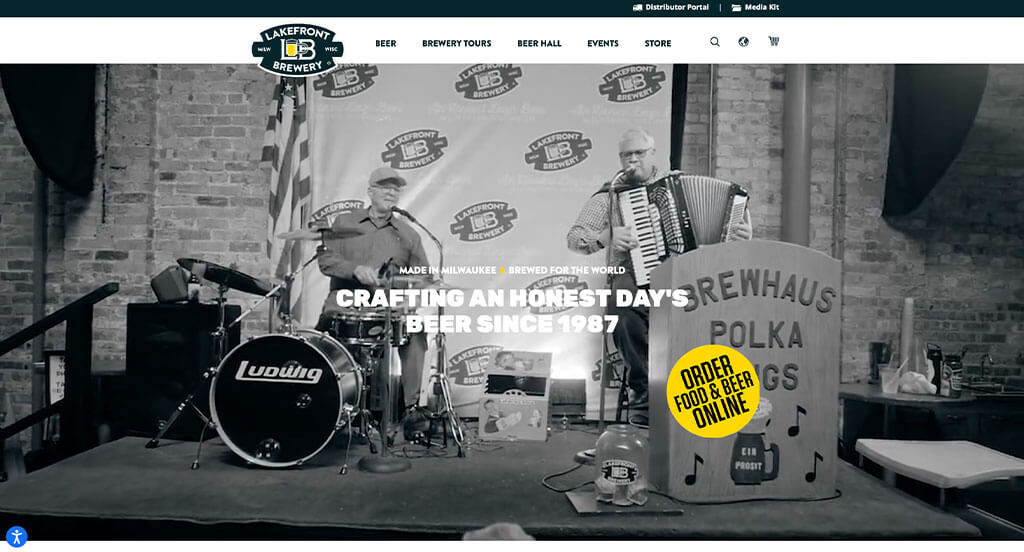
Lakefront Brewery has a great looking website that uses a black, white and yellow color scheme. The image backgrounds that were displayed in black and white while the products were in color was likely the most impactful quality in the homepage of this website. Their use of wooden patterns throughout the site was a unique choice for a custom website. They clearly had a focus on conversions when designing the domain for their website that matches their company name. These were just a few of the numerous good qualities in this website we had to consider when putting together the list of top websites for breweries.
WordPress Brewery Themes
You can find free themes at wordpress.org or explore brewery-inspired templates on ThemeForest.
Craft Beer – Themeforest
$69
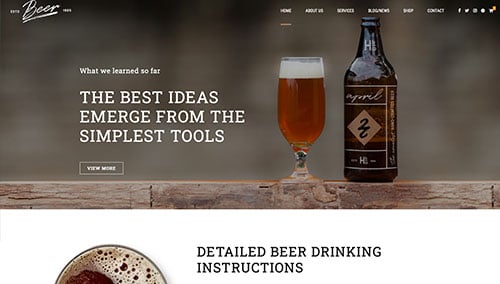
Brewski – Themeforest
$79
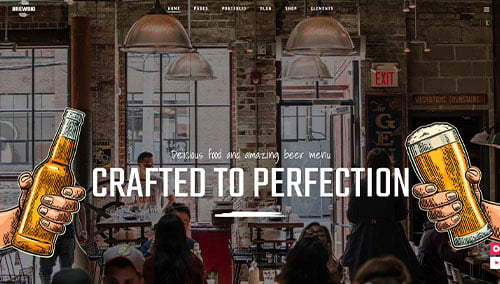
Bluebeard – Themeforest
$79
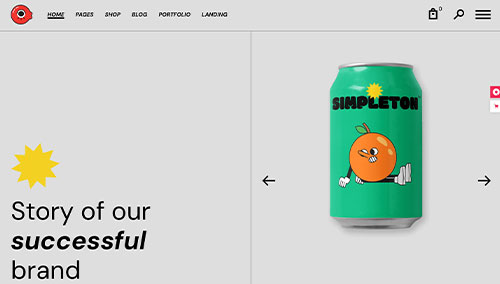
Weisber – Themeforest
$59
